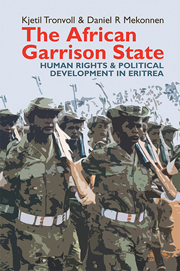Book contents
- Frontmatter
- Contents
- List of Acronyms and Abbreviations
- Preface
- Map 1 Provinces, Main Towns and Ethno-linguistic Groups of Eritrea
- 1 Introduction: The Eritrean Garrison State
- 2 Judicial Development in Independent Eritrea: Legal Pluralism and Political Containment
- 3 Rule of Law(lessness): The Special Court and the Judiciary
- 4 Democratic Curtailment: ‘Never Democracy, Always Control!’
- 5 Obliterating Civil Society: Denying Freedom of Organisation and Expression
- 6 The Eritrean Gulag Archipelago: Prison Conditions, Torture and Extrajudicial Killings
- 7 Everyday Life of Detention and Disappearances: Vulnerable Groups in a Population Under Siege
- 8 Minority Marginalisation: EPLF's Policies of ‘Cultural Superiority’
- 9 Diversity Diminished: Targeting the Kunama Minority Group
- 10 The Militarisation of Eritrean Society: Omnipresent and Never-Ending Military Service
- 11 Eritrea: Towards a Transition?
- Bibliography
- Index
2 - Judicial Development in Independent Eritrea: Legal Pluralism and Political Containment
Published online by Cambridge University Press: 05 October 2014
- Frontmatter
- Contents
- List of Acronyms and Abbreviations
- Preface
- Map 1 Provinces, Main Towns and Ethno-linguistic Groups of Eritrea
- 1 Introduction: The Eritrean Garrison State
- 2 Judicial Development in Independent Eritrea: Legal Pluralism and Political Containment
- 3 Rule of Law(lessness): The Special Court and the Judiciary
- 4 Democratic Curtailment: ‘Never Democracy, Always Control!’
- 5 Obliterating Civil Society: Denying Freedom of Organisation and Expression
- 6 The Eritrean Gulag Archipelago: Prison Conditions, Torture and Extrajudicial Killings
- 7 Everyday Life of Detention and Disappearances: Vulnerable Groups in a Population Under Siege
- 8 Minority Marginalisation: EPLF's Policies of ‘Cultural Superiority’
- 9 Diversity Diminished: Targeting the Kunama Minority Group
- 10 The Militarisation of Eritrean Society: Omnipresent and Never-Ending Military Service
- 11 Eritrea: Towards a Transition?
- Bibliography
- Index
Summary
INTRODUCTION
The land of Eritrea has, over the centuries, been controlled by different powers, all of which have left an imprint on both official and informal sources of law and legal authority in the country. During the last century Eritrea has experienced five radical political transitions all involving shifts of judicial authority. Consequently, in order to achieve a comprehensive understanding of the current workings of the judicial system and the rule of law in Eritrea, it is crucial to have knowledge about the historical trajectories of law in the country.
This chapter will thus first outline how the sources of law and legal authority in Eritrea have evolved historically. Thereafter the legal transition after military liberation in 1991 and de jure independence in 1993 and the constitution-drafting process will be discussed. Emphasis is put on how human rights issues have been handled in these processes.
SOURCES OF LAW AND LEGAL AUTHORITY
During pre-colonial times (prior to 1890), part of the Eritrean territory fell under the political realm of the Abyssinian state (Ethiopia). Eritrean highland society (kebessa) in particular was an integral part of Abyssinian feudal structures, as the governor paid tribute to the prince (ras) of Tigray, who was in turn subject to the authority of the king of kings (neguse-nagast), the emperor of Abyssinia. Hence, many of the customary sources of law still operating informally in Eritrea derive from, or are influenced by, an Abyssinian tradition. This is particularly relevant to customary forms of land tenure (Tronvoll 1998a).
- Type
- Chapter
- Information
- The African Garrison StateHuman Rights and Political Development in Eritrea, pp. 22 - 43Publisher: Boydell & BrewerPrint publication year: 2014



